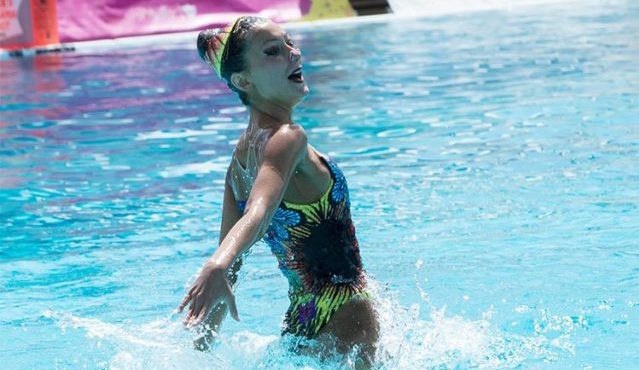Hooked on synchronized swimming after witnessing a team workout at the local YMCA, Ruby Remati has battled her way to the top of the sport in America.
When someone says “synchronized swimming,” do you picture ladies with flowered caps moving languidly through the water?
You better not, says Ruby Remati, the 2017 U.S. national champion in the solo and figures categories.
“It’s an extremely demanding sport, and it requires a lot of hours of training,” the 15-year-old says. “There are some people who look at is as a stereotype, but there are also a lot of people who find it really cool and unique. The reactions vary.”
Synchronized swimming is a unique mixture of dance, gymnastics and swimming, she explains. “It requires a lot of endurance and flexibility. We train, we do speed swimming, we do weight lifting, we train like rhythmic gymnasts do to improve flexibility.”
Unlike in the United States, the sport is popular in Russia, Spain and China, she says. “These are all the countries that are on the top right now, that are medaling. Russia, especially.”
Remati was born in Australia and holds U.S., Italian and Australian citizenship. She grew up in Andover, Mass., where she started synchronized swimming after she saw a team practice at her local YMCA. “Right away I loved the sport. I thought it was super cool,” she says. “My dad let me take a few classes, and then I joined the team.”
Her father, Battista, says it’s pretty rare for YMCAs to offer synchronized swimming. “I think that the sport found Ruby, as opposed to her finding the sport. I think we were just lucky to be in a situation where the local YMCA was a very good one.”
Remati and her parents moved in the summer of 2016 to Lafayette, Calif., so she could train full time with the national team. She has two older siblings, both in their 20s, who live on their own.
Her skills improved a great deal after moving to California, she says. At nationals last year she competed in solo, a routine set to music, and figures, which has no music and must include specific movements.
 Her goal is to make Team USA for the 2020 Olympic Games, she says.
Her goal is to make Team USA for the 2020 Olympic Games, she says.
Synchronized swimming became an official Olympic sport at the 1984 Summer Olympic Games in Los Angeles. The United States failed to send a team to the 2012 and 2016 Olympics, although it did have a duet team at both competitions.
“Going to the Olympics has always been one of my dreams. That wouldn’t happen if I stayed on my club team,” she says. “I’m very determined to make the Olympics.”
Her life these days consists of training six days a week from 7 a.m. to 2:30 p.m., starting with two hours in the gym followed by training in the water the rest of the time. Before big competitions, practices can last 11 hours. She also takes high school classes online and plans to go to college.
The current senior national team consists of about a dozen young women ages 15 to 18 and one man who competes in mixed duet. Despite the team’s youthful age range, longevity isn’t unheard of, she notes, with Olympic athletes competing into their 30s and even 40s.
This year, she didn’t attend nationals because she was chosen for the senior duet team along with Anita Alvarez, a U.S. Olympian she admires. Remati’s competition schedule this spring and summer included includes China, Japan, Canada and the American Open in June, then Hungary and the UANA Pan American Championships in August.
While being on a team means focusing on patterns and synchronization, duets allow for more unique and artistic routines, she says.
“Each year, I get better during competitions,” she says. “I do get pretty nervous before competitions, but I’ve learned that to defeat your nerves during competition, you just need to train hard during practice and treat every practice like it’s a competition.”
The above appeared in the June issue of the print version of Fra Noi. Our gorgeous, monthly magazine contains a veritable feast of news and views, profiles and features, entertainment and culture. To subscribe, click here.
 Fra Noi Embrace Your Inner Italian
Fra Noi Embrace Your Inner Italian







